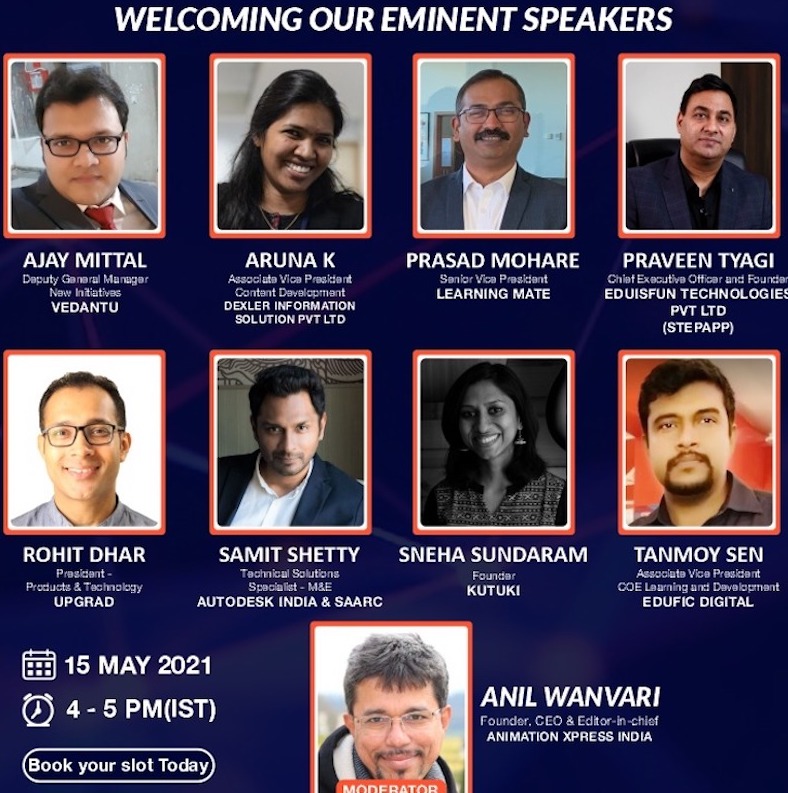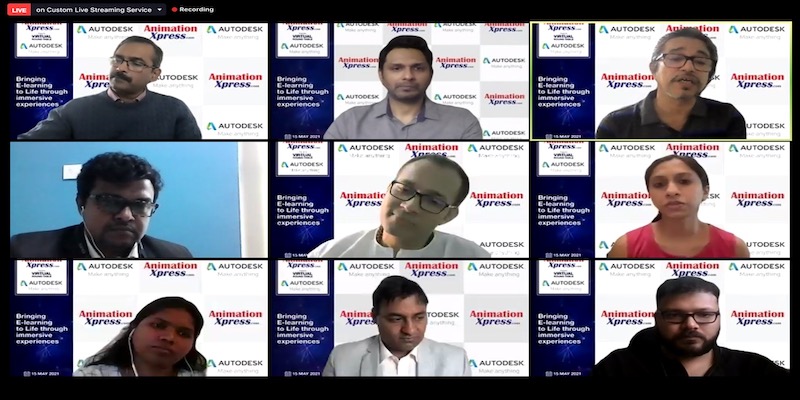
Powered by Autodesk, AnimationXpress hosted a webinar on ‘Bringing E-Learning to life through Immersive Experiences’ to evaluate the growth story of the medium and understand the forces behind its faced-paced growth and the bullish future projections.
E-learning has indeed seen a meteoric rise during the pandemic time as the population remained largely indoors and learning through the digital medium became their only choice.
To discuss the innovations, creativity, tools content creators are deploying to enhance learning outcomes, the spectrum of consumers it covers and how education can be taken to the next level with the help of emerging tools like AR and VR, various stakeholders of the Edtech industry joined the conversation.
Moderated by AnimationXpress India founder CEO & Editor-in-chief Anil Wanvari, the webinar was participated by Vedanti Deputy General Manager New Initiatives Ajay Mittal, Dexler Information Solutions Pvt Ltd Associate Vice President Content Development Aruna K, Learning Mate Senior Vice President Prasad Mohare, Eduisfun Technologies PVT LTD (STEPAPP) Chief Executive Officer and Founder Praveen Tyagi, Upgrad President – Products & Technology Rohit Dhar, Autodesk India & SAARC technical solutions – M&E Autodesk India & SAARC Samiti Shetty, KUTUKI founder Sneha Sundaram and Edufic Digital Associate Vice President COE learning and development Tanmoy Sen.

The online education market is poised to go upto about 15 billion dollars between 2020 and 2024, progressing at an annual growth rate of about 21 per cent. According to a report by technaview, there is going to be tremendous growth and the major growth which has come in the online education sector is from the content side. Content-based online education sector is anticipated to witness a gradual growth and will dominate the online education market between 2020 and 2024.
Throwing light on the learnings they’ve been able to glean in the pandemic in terms of creating content, Sundaram shared, “In terms of content strategy itself, we haven’t changed too much mainly because the core of what we do still applies because we cater to preschoolers. It is super important that any content we create should not be based on instruction because kids don’t learn with authoritarian and instruction-based methodology. What works best for children is focused on the creative medium of content which is why our curriculum strongly focuses on stories and songs which are not intrusive and strong. More so, now when young kids are alone at home and can’t meet friends, that’s when stories and songs come in useful. In terms of our strategy, we put young kids first keeping in mind their temperament and developmental stages that they go through at this stage. With learning companions like Kutuki, how each child is interpreting our stories and applying their lives has been interesting for us.”
Aruna K points that she hasn’t seen a major change in the content strategy for the market they cater to; large enterprise customer wherein that is mandatory training that they have to go through but keeping content crisper and simpler has become more important because in this pandemic everyone is restricted to the four walls of their homes.
Sharing what his observations vis-a-vis the evolution of digital learning, Ed-tech companies and content apps that Autodesk works together with, Shetty shares, “Story goes many years back. For me, the content meant only textbooks. I am not a good reader but still we had to read and depend on textbooks whereas nowadays there are so many varieties, visual content and creative ways to learn. It is definitely helping kids who are bent towards visual learning. I have been in touch with elearning companies. Kids have a lot of choices on content which is appealing and they can choose which content they want to go ahead with. Learning becomes faster. Content plays an important role. material is there but the task is how we put it into a visually appealing format to make the end user accept it. We need content for every age and every genre.”
Speaking about the upgradations they have brought along in the last 18 months, Dhar shares, “Lots of changes that have come in the last year. We had two apps for learning; which we recently combined in a single app for Upgrad. We have launched free courses within the app and we have also launched two minute bite-sized quick clips which we call shorts; “How to give an interview?”, “How to read a book” etc. We have long-form courses like certification courses (6 months, 3 months or Masters Degree), diploma, and we have partnered with top universities. So we are going all out in terms of making partnerships with multiple platforms, ecosystems, educational institutions and experts. The intent is to holistically help a learner who is in search of a career.”
Sen shares that the pandemic has pushed more and more people towards digital learning. He shares, “Primarily we have been in the space of creating digital content for custom learning organisations. Since we deal with B2B, we get specific requests based on the audience and requirements and then we start working on the storyboarding. Pandemic has accelerated the process of shifting to digital learning. The query is that they want the learners to have a crisp, short and straightforward content. We should create the content where people are getting engaged. Gamification is another way we can make it more interesting.”
Tyagi recounted that back in the times he knew within a minute whether the teacher entering the classroom would be able to teach him effectively or not. According to him, the same is happening with Ed-tech companies; they are all trying to integrate technology but focus should lie in making education fun.
He shares, “I believe education can be made fun. Stepapp is totally gamified. We focus on gamified format. Thousands of kendriya vidyalayas, everywhere the feedback is amazing because we have broken down concepts into the smallest possible quantum granule and made it feel like a game rewards and points. For junior classes, gamified stories whether a child wants to watch stories or access the internet.. I believe gamified stories are the way forward. Education must be interesting and it should be the next level. Solution is not just recording a classroom lecture, it should be made more engaging through creative ways like gamification.”
Talking about how the content has evolved from the pedagogy perspective, Mittal shares, their focus has been on learning outcomes. “How do we personalise the learning outcomes for each child? We are investing in solutions which can homogenise the classrooms. We have been working hard in that direction. The uptick in the overall outcomes of the students is very encouraging. To evolve the content according to the new age; we are integrating simulations, 3D, etc. There is a thin line between gamifying the content and actually creating a game. Our assets are AR-enabled,“ he shares.
Speaking about the post-pandemic impacts on their content strategy, Mohare shares, “While we don’t serve the Indian market it is absolutely great and encouraging to hear how the market is growing in India. My concern is the smaller institutions who are behind on the digital transformation curve and are on the verge of a shutdown due to the pandemic. This has been my concern because this situation has taught them that they need a plan B.
Pointing out two fundamental problems he has identified, he noted, “Issues we found were; how do I take my classroom content digital? Several institutions are still figuring that out. They are realising that zoomification is not the way and they are looking at new ways. User-centric design is fundamental to our process. Faculty and the digital literacy gap that they have; from having a marker and whiteboard, today we have to teach a class in a different way.”
He also adds that blended learning flipped classroom model is one way of getting out of zoomified education. Building on the notion, Tyagi points out that learning must be out of curiosity and it should be child centric and feedback driven and all our solutions should be created around that.”
Sundaram highlighted that pre-school education hasn’t had much innovation. She expounds, “Either things are force-fed from the west. Very young children learn from what they know. When you expose them to things they are not familiar with. When they see characters they are not familiar with them, it has an impact on their learning. I didn’t realise the depth of it. Formative years are so important in setting the context. Especially when you’re building content for India, it is important to contextualise.”
Panelists agreed that while ROI (Return on Investment) is important since it also helps them determine how workable and effective their digital learning solutions are.
Outlining his vision for India’s education system, Tyagi shared, “My mission is that we create a level playing field in the country. In stepapp we don’t have a face of a teacher; at the moment we are selling it all across the world. The moment you gamify, you have created a solution for the globe. I have taught many IIT students from rich and elite backgrounds but now I want education to reach all sections of society.”
For enquiries: India.dg@autodesk.com

